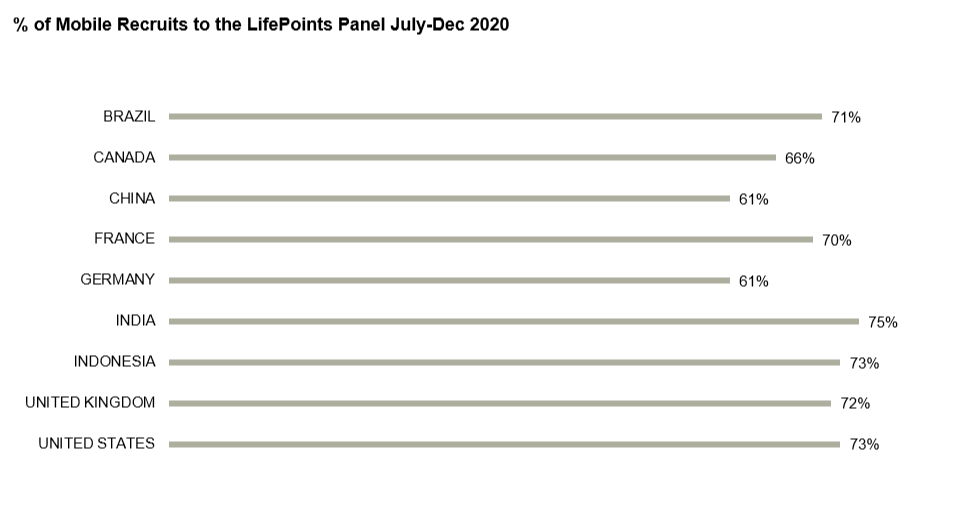Change and transformation – it’s inevitable in the digital and tech environment, if you want to remain relevant and sustainable. For market researchers, it’s critical in the fight for the attention of time-poor consumers and access to them.
The recent global pandemic has forced many industries into change, and in some cases, sped up transformation – including our own business at Kantar. More importantly, consumers are requiring a change to the way we collect data from them; they demand fast and frictionless experiences. So, if you haven’t begun adapting your quantitative research practices yet – start with designing online surveys for mobile respondents.
Consumers want to take surveys on mobile devices
First and foremost, people want to participate in research on mobile devices. Globally, 67% of double opt-in respondents Kantar recruited for our LifePoints panel between July and December 2020 came from mobile devices. In addition, 40% of all survey starts were done on a mobile device during that same period.

However, the reality is that nearly 67% of surveys that are conducted aren’t compatible or easy to take on a respondent’s device of choice. These surveys either aren’t built using responsive tools, or the overall design was not created to engage mobile respondents.
If people are asking for mobile surveys – why aren’t those changes being made? Likely because adapting survey research isn’t always easy or straightforward. Unfortunately, research loses out in the long term by favoring the trade-off of using older survey designs for consistency over access to a representative and engaged audience.
Change can require a shift in survey scripting techniques, questionnaire designs and scrutinizing data returns. When engaging a mobile audience, it’s necessary to ask questions people want to answer, in a way it is easy for them to answer, and in a time frame where they can remain focused. Time-poor consumers have little interest in being asked a long list of questions filled with grids and redundancies. Gone are the data-entry centric, prescriptive question formats, and in are conversational question formats.
Using mobile-friendly designs is necessary for sustaining the value of research. But if you are just starting out, or if you know your approach needs adapting, where can you start?
How do you get started designing surveys for mobile?
1. Tap into reactive survey design tools
Consumers are people, and people are reactive. Why aren’t surveys? Don’t force respondents to zoom, scroll or rotate their phones to read and answer your questions. Use tools that are device and screen size agnostic – creating less friction for respondents to complete the survey.
2. Append more data, ask fewer questions
We can be smarter about the data we collect and connect by integrating insights with other data, such as survey data from syndicated studies, social media, and behavioral data. There are a lot of great things happening in our industry – we can now capture a holistic view of the consumer without asking a lot of questions. Use the effects of mobile to our advantage, not just adapt to evolving technologies.
3. Use visuals and iconography
Apply icons and images strategically to reduce the load on respondent’s working memory and create visual triggers, especially in repetitive questions. Visual content works; 40% of people will respond better to visuals than just plain text. Put aesthetics onto your survey agenda.
4. Consider your audience
Who are you interviewing? Women with kids? Business managers? Medical professionals? Speak in a voice that will resonate best with them and use words you’re confident that they’ll understand. This includes tone and language. If you want an engaged respondent, create a conversation specific to the people you’re speaking with. Regardless of who your audience is, try avoiding boring and stiff language that demotes openness.
5. Write how people read and be concise
If you’re looking to shorten your length of interview, simplicity is key. Keep your sentence structure simple and brief and cut unnecessary words that don’t add to the question or background. Try utilizing the Twitter mentality: keep it short and concise and easy to digest. Also, if you find that your survey takes longer than 15 minutes to complete, consider splitting the survey into two or use modular concepts.
6. Test your surveys multiple times and edit
Be sure to read, re-read, test and re-test your surveys on a mobile device. Consider having a co-worker or someone outside of your business unit test designs as well. Multiple reviewers will not only spot if something doesn’t make sense or reads awkwardly, they will identify points of friction that can be modified.
In the year 2021, there is no better time for researchers to take advantage of technological advancements being made to ensure the delivery of representative and compliant data and insights at the speed of life. Now is the time to adapt data collection to work with consumer behavior and technology of today, rather than against it.
More on survey design tips and best practices
For more on survey design techniques, access 12 tips for writing better survey questions here, or try our on-demand survey design training modules.

